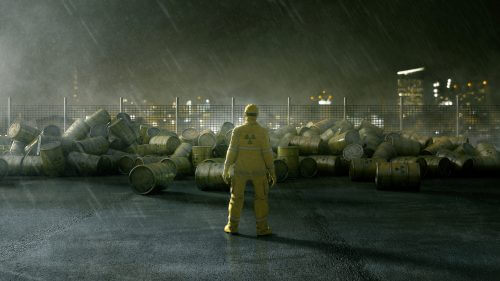Researchers from the Hebrew University have developed a substance capable of binding the radioactive isotope 'Cesium 137' in water, thereby purifying it. This toxic isotope appeared after the nuclear explosion in Chernobyl and the disaster in Fukushima. The new material is effective, easy to prepare and does not require a lot of financial investment

One of the biggest problems in working with radioactive materials is contamination of soil and water with radioactive waste. This waste emits dangerous radiation even in minute quantities, and its treatment is complicated and expensive. One of the by-products of the nuclear fission of uranium is the radioactive isotope 'Cesium 137', which is very similar in its properties to potassium, even though it has a half-life of about 30 years. 'Cesium 134' is able to be absorbed by bones and muscles, and it appeared around the Japanese city of Fukushima after the nuclear disaster that happened in 2011 and was released into the air in the nuclear explosion in Chernobyl in Ukraine, then this isotope entered the grass that the cows ate and the radioactive contamination accumulated in their milk.
In fact, only half of the material will decompose after 30 years, continuing to be a dangerous pollutant that emits radiation for decades. In addition, the cesium salts, like the sodium and potassium salts, are very soluble in water and do not tend to react with many substances, which makes it difficult to purify water from cesium impurities. There are some chemical reagents capable of binding cesium salts from aqueous solutions and precipitating them, but they are expensive and their use is limited.
The research work was carried out by PhD student Raval Bangyat in the laboratory of Prof. Yossi Almog in collaboration with Prof. Danny Mandler from the Institute of Chemistry at the Hebrew University, and will be published in Chemistry a European Journal during the next month. The researchers were able to develop a new material capable of binding cesium ions in water, and as a result precipitate them into an insoluble and stable complex. The results of the research state that the new material can be mixed with water contaminated with cesium, and the sediment containing the contamination can be filtered from it and thus purified.
And for the scientific explanation: organic substances that bind these metals are called "ligands". The developed ligand includes a kind of "cage" of oxygen groups that specifically fits the dimensions of the cesium ion. This leads to a selective capture of the cesium from a solution containing different ions, which are not suitable in size for this cage. Since in natural water sources there are many types of ions, which may be found in a much higher quantity than the cesium ion, the selectivity is important in order to lead to a specific capture of the cesium, without using very large amounts of material and changing the composition of the water.
Another important feature of the material said to remove radioactive waste is resistance to gamma radiation. It was found that the ligand and the complex are indeed resistant to radiation, which ensures the stability of the precipitate after the cesium capture. Using the material, it will be possible to remove cesium waste from water relatively easily, thus effectively treating water contamination caused by malfunctions in nuclear reactors.
Prof. Almog from the Hebrew University describes the material found: "For about a decade we have been researching a group of substances called 'vazaranim' because of their shape similar to a pot ('vaza' in Latin) which are able to bind various ions and salts. As part of the research, many 'Vazarenes' were prepared and their properties were studied, especially their potential in the field of analytical chemistry. The molecule of one of the 'Wazarenes', known as the 'alloxan tray', included a previously unknown spatial array of six carbonyl groups, which, based on their position in space, we expected would be exactly suitable for the binding of cesium ions, which are the largest monoatomic ions."
Prof. Almog further explains: "Indeed, the alloxan tray reacted with cesium ions in aqueous solutions and formed an insoluble complex with them that sank out of the solution and can be easily separated. Beyond the successful precipitation of the cesium ions, the new compound has a significant advantage - the ease of preparation. The alloxan tray can be made with high utilization of available and inexpensive starting materials."

One response
An interesting and well-balanced article. It may take talent to catch cesium in water, but you need to be an artist to make this information accessible to the general public.